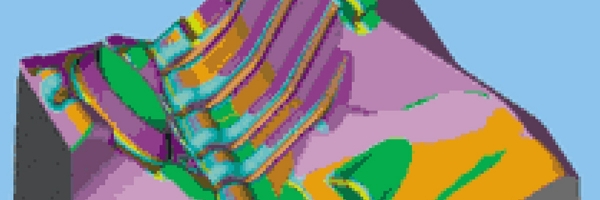Driving for Success at EXCO Engineering
EXCO Engineering (Newmarket, ON) specializes in die cast automotive dies for companies like General Motors, Chrysler, Ford, and Saturn. In business since 1954, the company currently employs around 140 people. Back in 1992, engineers at EXCO were working on a die cast die used to produce the 3-liter front wheel drive transmission case for Ford. Similar to work they done before, but this time, they wanted to go straight to steel. “This was the first job we’d used computer generated programs to rough machine inserts for this type of part,” said Brian Roberts, NC Coordinator.
“It was a challenge. We wanted to go straight to steel with the roughing programs without doing a test run. There was the question of a collision or breaking a tool. We also wanted to make sure that these programs would be at least as fast as duplicating from physical models.” Up until that point, EXCO had the same NC machining problems that most shops have just learned to live with, such as too many program gouges, breaking tools, more scrap than they wanted, and an occasional machine tool crash.
The NC programmers at EXCO decided it was time to try a new approach. First, they built the tool paths for the Ford job in CATIA on a UNIX workstation. After they generated each cutter path they ran it though VERICUT, an NC verification program by CGTech (Irvine, California). VERICUT simulates the machining and the material-removal process of the NC tool path in order to detect any potential problems before actual machining. EXCO Engineering chose the program because it is the best package for tool definition and visual display of gouges. “This was the first time we’d used VERICUT,” said Dave Collings, System Manager. “The on-line verification system right at the workstation enabled us to visualize and modify the program until we were satisfied with the tooling and the start and end points. It also enabled us remove all moves that would gouged the part.”
VERICUT showed the NC programmers leftover or heavy stock. “And the software detected a couple of places where the depth of cut was too large and tools were shanking out,” said Collings. They then went back and corrected the errors in the tool path before sending the program to the machine. Additionally, VERICUT displayed the run time so they knew it would machine in the scheduled amount of time.
When they were confident that the NC programs were ready, it was time for the real test. They set up the machine and loaded the roughing programs without doing a single prove-out. “The result was that we were able to go ‘straight to steel’ and had absolutely no problems with tool breakage, collisions, or excessive tool wear due to long run times. We saved a lot of time and re-work with VERICUT on that project.” said Roberts.
VERICUT is now a part of the everyday process at EXCO Engineering. “We’ve moved VERICUT over to an ALR Revolution system (four Pentium Pro 200 processors with 512 Mb of RAM) running Windows NT. With this setup, we can run six VERICUT licenses on one system and display the graphics locally on the UNIX workstations where the NC programmers are running CATIA,” said Collings. This allows all the NC programmers to use a central VERICUT tool library. “We have 10 NC programmers here. Before we got VERICUT we didn’t have standard tooling for NC programmers. Now we have a central tool library that has definitions for all the tools used on the shop floor. If the shop floor runs the NC programs based on the tooling specified and tested in VERICUT, there will be no problems.” Running multiple licenses of VERICUT on the beefed-up NT box and piping the display out to the NC programmers’ terminals also maximizes their CAD/CAM software performance.
Implementing the NC verification software into the everyday manufacturing process has paid off big for EXCO Engineering. Over the past six years the company has saved countless thousands of dollars and man-hours by Doing virtual prove-outs to test the tool/shank/holders and avoiding gouges and collisions. “It has also made scheduling and job flow a lot easier because we know program run time beforehand and we can use the software to visually optimize the cutter path,” said Collings.” All this without loosing a single minute of machine time to test the NC program with a dry run on plastic. “It’s a big improvement to get the program to the shop floor right the first time. Not only do we get better cutting results, but we can show a simulation before even starting the job. That aspect makes it an excellent project management tool.”
Productivity has increased as a result of implementing VERICUT into the everyday process. “All of our 30 machinists have a lot of confidence in the new NC programs so they’re not afraid to leave the machine with a new job running. This has enabled us to have one operator running multiple machines,” said Roberts.
 Germany
Germany Italy
Italy USA
USA South Korea
South Korea UK
UK India
India France
France China
China Japan
Japan
